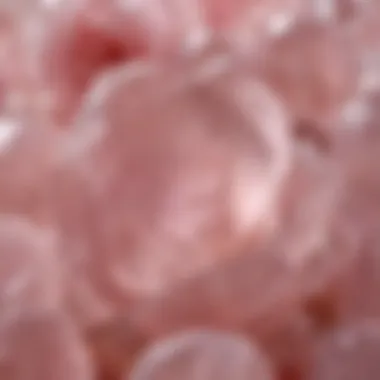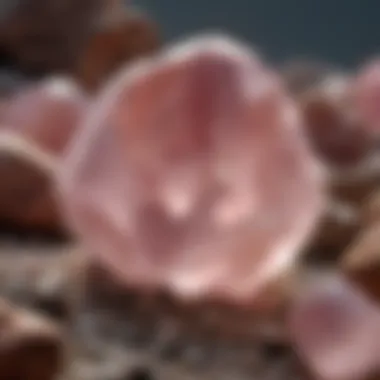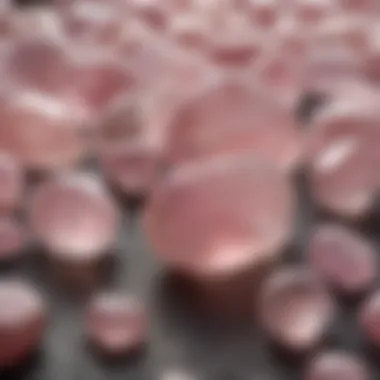Exploring Natural Rose Quartz: A Comprehensive Overview


Intro
Natural rose quartz is not merely a stone; it holds a wealth of attributes that attract collectors and enthusiasts alike. This pink mineral, widespread in various geological settings, carries a certain allure. Geologically, it forms under specific conditions, primarily within igneous and metamorphic environments. The delicate coloring evokes a sense of beauty and softness, which can sometimes veil its fascinating complexity.
Understanding the broader implications of natural rose quartz involves examining its physical properties, cultural representations, and historical relevance. Each section of this article will delve deeper into these aspects, guiding you through the intricacies of this remarkable mineral.
Rock and Fossil Identification
When identifying rose quartz, it is crucial to consider its specific characteristics. The mineral displays a distinct pink hue, often varying from pale to vivid shades. This coloration results from manganese and other trace elements during formation. Here are some key traits to help in identification:
- Color: Primarily pink but can have color zoning.
- Transparency: Generally translucent to opaque.
- Luster: Vitreous to pearly.
- Hardness: Scores 7 on the Mohs scale, making it relatively durable.
Utilizing the right tools can make identification easier. A standard geologist's hammer and a magnifying glass can assist in examining the rock's texture and clarity.
Characteristics to Look For
When distinguishing rose quartz from similar minerals, focus on these characteristics:
- Crystals: Unlike many quartz types, rose quartz rarely forms well-defined crystals.
- Inclusions: Examine for rutile or other minerals within the quartz matrix.
- Cutting Surface: A polished surface can reveal flaws and inclusions that might not be visible otherwise.
Tools for Identification
To accurately identify natural rose quartz, collectors should consider using:
- A geological hammer for specimen collection.
- A hand lens for detailed examination.
- A field guide for reference on mineral identification.
Collecting Tips and Techniques
For those keen on gathering rose quartz specimens, employ best practices to ensure a successful outing. Effective collecting not only hints at the thrill of discovery but fosters respect for the environment.
Best Practices for Collecting
- Always seek permission where necessary. Many sites may have regulations.
- Take only what you need. Sustainable practices should remain a priority.
- Document your findings. Note exact locations and conditions.
Locating Prime Collecting Sites
Researching geological maps or engaging with local rock clubs can unveil fruitful locations. Notable places for rose quartz include:
- Madagascar - Known for its high-quality rose quartz.
- United States - Zones in South Dakota and California often yield specimens.
How to Safely Extract Specimens
Employ correct techniques to minimize damage to the site or specimen:
- Use your hammer gently to avoid breaking the rock.
- Wear safety goggles to protect your eyes from flying debris.
Preservation and Display
Once you have collected natural rose quartz, it is important to maintain its integrity and beauty. Proper preservation techniques can extend the life of your specimens.
Techniques for Preserving Rocks and Fossils
- Store in a dry environment to prevent moisture damage.
- Keep away from direct sunlight to avoid fading.
Proper Storage Methods
- Use padded boxes or containers made of acid-free materials.
- Avoid stacking specimens directly on top of one another.
Creative Display Ideas
Displays can enhance appreciation for your collection. Consider:
- Shadow boxes for individual specimens.
- Glass domes for highlighting larger pieces.
Geological Insights
To appreciate natural rose quartz, one must understand geological contexts. This understanding can deepen appreciation for the mineral's formation and history.
Geological Formations and Processes
Rose quartz forms primarily in pegmatitic environments. The slow cooling of magma creates opportunities for the necessary components to crystallize into this lovely mineral.
Historical Significance of Rocks and Fossils


Historically, rose quartz has appeared in various cultures. Ancient Romans, for instance, believed it had protective properties. Today, it carries metaphysical significance in many spiritual practices.
Notable Discoveries in the Field
Various sites worldwide yield findings of remarkable rose quartz deposits. Discoveries often lead to insights into Earth’s geological history, enriching both academic and collector communities.
"Natural rose quartz is more than just a beautiful stone. It symbolizes emotions, harmony, and connections across various cultures."
Ultimately, natural rose quartz symbolizes beauty and depth in the Earth’s mineral kingdom. Through this exploration, collectors and enthusiasts alike can gain a deeper understanding and appreciation for this captivating stone.
Prologue to Natural Rose Quartz
Natural rose quartz, a stunning pink mineral, is celebrated not only for its beauty but also for its diverse applications and historical significance. Understanding rose quartz is essential for both collectors and enthusiasts. This section serves as a starting point, providing insight into what makes this mineral noteworthy.
Definition and Basic Characteristics
Rose quartz is a variety of quartz, primarily composed of silicon dioxide. Its distinctive color ranges from a pale pink to a deeper, vibrant hue. The presence of trace minerals, such as titanium and iron, contributes to this coloration. Crystals can appear translucent to opaque, often exhibiting a milky luster. This mineral typically forms in massive deposits rather than individual crystals.
In terms of physical attributes, rose quartz ranks at 7 on the Mohs hardness scale, indicating good durability. Its unique color has led to its usage in various forms, including jewelry, carvings, and decorative items. The intriguing qualities extend beyond aesthetics, as many believe in its metaphysical benefits, including emotional healing and love.
Historical Context
The history of rose quartz is rich and multifaceted, dating back to ancient civilizations. Egyptians are known to have used rose quartz in amulets and ornaments, linking it to beauty and protection. The Greeks associated it with the goddess Aphrodite, symbolizing love and passion. In other cultures, such as the Chinese, rose quartz was believed to promote healing and emotional well-being.
Throughout the ages, civilizations have valued this mineral not only for its beauty but for its supposed powers. Today, the interest in rose quartz continues, as both its historical significance and contemporary applications maintain its allure in the world of collecting and alternative healing practices.
Geological Formation
Understanding the geological formation of natural rose quartz is vital for appreciating its unique characteristics and relevance within the mineral realm. The processes by which this stone is formed not only highlight its inherent properties but also contribute to its appeal among collectors and enthusiasts alike. This section unveils the mineral composition, formation processes, and geographical locations of natural rose quartz—elements that illuminate why this mineral captivates so many.
Mineral Composition
Natural rose quartz is primarily composed of silicon dioxide. This fundamental component makes it apart of the larger quartz family. Its structure can contain trace elements such as titanium, iron, and manganese, which introduce the delicate pink hue that is characteristic of this mineral. The presence of these trace elements alters its color and can even impact its clarity and luster.
Collectively, the mineral composition contributes to the stone's aesthetic appeal while also defining its physical properties. Rock and fossil collectors often seek out specimens based on these nuanced variations in composition, which can indicate the specific environmental conditions in which the quartz formed.
Formation Process
The formation of natural rose quartz involves a series of geological processes that unfold over millions of years. Rose quartz is predominantly found in igneous and metamorphic rocks, where it crystallizes slowly under high temperature and pressure conditions. The formation begins in a molten state as silica-rich magma cools, allowing quartz crystals to form. The addition of certain minerals during this cooling phase is what gives rise to the pink coloration.
During the metamorphic processes, existing quartz can undergo a transformation due to changes in temperature and pressure, further enhancing its gradient of colors and introducing new complexities to its structure. The prolonged periods required for these transformations explain why high-quality specimens often hold significant value.
Sources and Locations
Natural rose quartz can be found in several geographic locations, each with distinct characteristics. Major sources include Brazil, Madagascar, and South Africa, known for their abundant deposits and striking specimens. In Brazil, large quartz crystals can be found, often displaying vibrant pink shades. Madagascar is famous for its high-quality rose quartz streaked with white or even deeper pink tones.
Other notable locations include:
- United States: Particularly in South Dakota and Arkansas, where quartz deposits are common.
- Japan: Known for unique pink hues not found elsewhere.
- India: Features variations with inclusions that appeal to collectors.
Understanding these sources enhances one’s knowledge of the market and assists collectors in distinguishing between genuine and artificially enhanced stones. The diverse origins also indicate potential variations in physical properties, making collecting even more engaging.
Physical Properties
The physical properties of natural rose quartz play a critical role in understanding not just its beauty, but also its practical applications. These attributes furnish collectors and enthusiasts with essential information that informs both identification and valuation. In this section, we will detail the various aspects of rose quartz that define its appeal.
Color Variations
Natural rose quartz is primarily known for its gentle pink hue, which ranges from pale blush to vibrant raspberry. The color intensity depends on the presence of trace minerals during its formation. Iron is a significant contributor to these color variations. Additionally, microscopic inclusions can cause the color to appear more saturated in certain specimens. The pink tones within rose quartz evoke feelings of warmth and affection, enhancing its desirability in jewelry and decorative items.
Collectors should be aware that while color is important, it should not be the sole criteria for assessment. Examining a piece thoroughly can be crucial for recognizing its unique shade and potential value.
Hardness and Durability
Rose quartz ranks 7 on the Mohs scale of mineral hardness. This ranking indicates a solid level of durability, making it suitable for a variety of uses without significant risk of scratching. However, while it is relatively tough, care must still be taken to avoid chipping. The combination of its hardness and aesthetic appeal contributes to its popularity in jewelry making. Many designers favor rose quartz for rings, pendants, and bracelets that resist everyday wear and tear.
It is important for collectors to keep in mind that durability plays a vital role when considering rose quartz for practical applications, especially in items worn frequently.
Luster and Clarity
The luster of rose quartz is typically described as vitreous to pearly, offering a subtle shine that enhances its visual appeal. Such luster can vary from one specimen to another. This has an impact on how light interacts with the stone, further influencing its perceived beauty.
Clarity is another crucial aspect. Unlike some gemstones, rose quartz is rarely found in perfect clarity. It often contains veils, clouds, or even rutile inclusions, which add to its character rather than detract from it. These inclusions can cause the stone to appear more translucent, impacting both its aesthetics and value.
"The combination of a stone's luster and clarity can significantly influence its visual texture and appeal to collectors."


For collectors, being aware of these properties can aid in choosing quality specimens while also understanding the market dynamics surrounding rose quartz.
Uses and Applications
Natural rose quartz finds its place in various fields, notably in jewelry, healing practices, and industrial use. This section highlights the multifaceted appeal of rose quartz, discussing its significance in each context alongside practical considerations for those interested in its various applications.
Jewelry and Ornamentation
Jewelry made from natural rose quartz serves not only as decorative items but also as symbols of sophistication. The soft pink hue combined with the transparency makes it attractive for rings, necklaces, bracelets, and earrings. This stone is often set in both precious and non-precious metals, depending on the desired aesthetic.
- Rose quartz is widely used in handmade jewelry, appealing to artisans for its unique color and energy.
- Its affordability compared to other gemstones makes it a popular choice for fashion enthusiasts.
- Many wear rose quartz as a talisman. Some people believe it can attract love and compassion. This belief enhances its demand in the jewelry market.
Additionally, the quality of rose quartz can vary. Factors such as color saturation, clarity, and cut significantly influence its market value. Collectors often seek well-crafted pieces that highlight the stone's natural beauty.
Metaphysical Properties
Natural rose quartz is associated with several metaphysical beliefs. Many practitioners of alternative healing consider it a powerful tool for emotional healing and spiritual growth. Its proponents suggest that it promotes love, harmony, and empathy.
- It is often used in meditation and energy healing.
- Some claim that placing rose quartz in a room can create a calming atmosphere.
- It is commonly used in crystal healing to support emotional balance during times of stress or heartbreak.
In spiritual circles, rose quartz is often seen as a heart chakra stone. Individuals may use it to enhance feelings of self-love and acceptance. While scientific validation for these claims is limited, many individuals report positive personal experiences, which contributes to its ongoing popularity in spiritual practices.
Industrial Applications
Though primarily known for its beauty, rose quartz also has practical uses in various industries. Its hardness, along with its ability to withstand heat, makes it suitable for several industrial applications.
- In electronics, rose quartz is used to produce oscillators. These components are critical for maintaining precise frequencies in devices.
- Its durability lends itself to use in countertops and surfaces, where aesthetics meet functionality.
- Some cosmetics incorporate rose quartz in formulations, as it is believed to enhance skin health by soothing and calming.
Understanding these diverse applications of natural rose quartz underscores its importance beyond aesthetics. Collectors and enthusiasts should recognize not only its jewelry appeal but also its broader role in society and industry.
"Natural rose quartz serves multiple functions. Its use in jewelry, spiritual practices, and industry reflects its diverse appeal."
Cultural Significance
Natural rose quartz extends beyond its aesthetic appeal, serving as a touchstone for various cultures through time. Its significance is not just in its beauty but also in the beliefs and values that societies have assigned to it. Understanding this cultural dimension is vital. It provides insight into the historical context behind the use of rose quartz and allows modern collectors and enthusiasts to appreciate the mineral on a deeper level.
Historical Uses in Ancient Civilizations
In ancient civilizations, rose quartz found itself integrated into daily life and rituals. The Egyptians crafted amulets and other ornamental objects, believing that the stone possessed protective qualities against evil spirits. It was often associated with love and fertility, suggesting a reverence for its soft pink color, which was seen as reflective of the life-force.
The Greeks and Romans also valued rose quartz. They believed it was a powerful aphrodisiac, fostering love and passion. Many artifacts recovered from ancient sites showcase intricate carvings made from this stone. These historical uses exemplify how rose quartz has continuously been linked to themes of love, beauty, and protection.
Modern Spiritual Practices
In contemporary settings, rose quartz is widely recognized within modern spiritual practices. It has developed a reputation as the "stone of unconditional love." Practitioners of various spiritual traditions utilize it for healing and emotional balance. Meditation with rose quartz is said to promote feelings of peace, calm, and healing, allowing individuals to enhance their emotional resilience.
Moreover, in the realm of crystal therapy, rose quartz is frequently recommended for those looking to mend emotional wounds or foster romantic relationships. Its current use in wellness practices emphasizes a continuity in how this stone is viewed—not merely as a decorative piece but as a tool for personal and spiritual growth.
Symbolism in Art and Literature
Rose quartz has found significant place in art and literature, symbolizing various themes such as love, compassion, and emotional depth. Artists often incorporate rose quartz to evoke feelings of tenderness and warmth in their works. The stone's soothing hue can have a calming aesthetic that resonates with viewers, making it a popular choice in jewelry and decorative arts.
In literature, rose quartz may appear as a metaphor for romantic relationships or emotional healing. Writers have drawn upon its symbolism to elevate narratives surrounding love and connection. This connection between rose quartz and deeper human emotions illustrates its evolving significance in culture over centuries.
In summary, rose quartz serves as an enduring cultural artifact, encapsulating themes of love, protection, and emotional healing across various societies throughout history. The exploration of its historical uses, modern applications in spirituality, and representation in art and literature showcases its multifaceted role in human culture.
Understanding these cultural dimensions enhances the appeal of rose quartz for collectors and enthusiasts alike, establishing a bridge between its physical characteristics and the rich tapestry of meaning assigned to it.
Collecting Natural Rose Quartz
Collecting natural rose quartz offers enthusiasts both an engaging hobby and an opportunity to appreciate the unique characteristics of this mineral. The increasing popularity of collecting crystals adds to the allure of rose quartz, making it a sought-after specimen not only for its aesthetic appeal but also for its purported properties. Understanding the aspects related to
- identification,
- care,
- valuation,
is crucial for both novice and experienced collectors. Knowing how to identify authentic pieces is essential to avoid counterfeits. Proper care ensures longevity and visual appeal. Knowing market trends informs buying and selling decisions.
Identification and Authenticity
Authenticating natural rose quartz requires several key observations. While the soft pink color is a signature trait, other factors differentiate genuine stones from synthetics and imitations.
- Visual Inspection: Look for inclusions or color variations within the stone. Natural variations contribute to thestone's uniqueness.
- Scratch Test: Rose quartz typically rates between 7 on the Mohs scale of hardness. Using a common material like glass can help verify its durability and composition.
- Light Test: High-quality rose quartz allows light to pass through but may show slight opacity. Observe how light interacts with the piece.
- Professional Appraisal: Consulting a gemologist can provide definitive insights about authenticity.
Care and Preservation


Proper care is vital for maintaining the beauty of natural rose quartz. A few steps collectors can take include:
- Cleaning: Use warm soapy water and a soft cloth to clean the surface. Avoid harsh chemicals that can harm the stone.
- Storage: Store pieces in a cool, dry place, ideally wrapped in soft cloth to prevent scratches.
- Display: If displayed, ensure they are not exposed to excess sunlight, which may fade the color over time.
- Handling: Avoid dropping or tapping against hard surfaces to prevent chips and fractures.
Valuation and Market Trends
Understanding the valuation of natural rose quartz requires an awareness of market dynamics. Key factors influencing its value include:
- Quality of Color: Deep, even pink shades are generally more valuable. Pale or mixed colors may be less sought after.
- Size and Shape: Larger specimens or unique cuts attract higher prices, appealing to collectors seeking standout pieces.
- Rarity: Certain formations or colors that are harder to find may command a premium.
In recent years, there has been a noticeable increase in the demand for natural rose quartz, especially among collectors who appreciate both its aesthetics and metaphysical properties. Staying informed about these trends helps collectors make informed decisions regarding buying and selling.
"Natural rose quartz not only captivates with its appearance, but also enriches with its cultural and historical significance."
The world of collecting natural rose quartz is vast and rewarding. Engaging with these elements enhances the experience for both new and experienced collectors alike.
Environmental Considerations
The topic of environmental considerations is crucial when discussing natural rose quartz. This section addresses the impact of mining practices and the effects on local ecosystems. Understanding these aspects helps us appreciate the delicate balance between resource extraction and environmental preservation. Sustainable practices in mining are essential for minimizing the negative consequences associated with rose quartz extraction.
Sustainability in Mining Practices
Sustainability in mining practices aims to reduce the environmental footprint of extracting natural rose quartz. Many mining operations often prioritize profit over environmental health, leading to land degradation, water pollution, and habitat destruction. However, through sustainable practices, miners can mitigate these impacts.
Some strategies include:
- Implementing responsible sourcing policies to ensure that the materials used are obtained ethically.
- Utilizing eco-friendly extraction methods to minimize damage to the surrounding environment.
- Restoring mined areas through rehabilitation programs, which involve reforesting or rehabilitating land for other uses.
By adopting such practices, we can maintain the integrity of the ecosystems where rose quartz is found and ensure this beautiful mineral remains available for generations to come.
Impact on Local Ecosystems
The impact of rose quartz mining on local ecosystems can be significant. Mining operations disrupt the natural habitat, affecting flora and fauna. Immediate effects often include loss of biodiversity and alteration of landscape. Long-term consequences can manifest as soil erosion and changes to water quality in nearby streams and rivers.
There are several factors to consider:
- Water Pollution: Mining activities can introduce harmful substances into water sources, adversely affecting aquatic life.
- Habitat Loss: The clearing of land for mining can decimate local wildlife populations, disrupting their natural behavior and lifecycle.
- Trophic Cascade: The removal of key species can trigger a cascade effect throughout the ecosystem, leading to further ecological imbalance.
Protecting local ecosystems requires a commitment from both miners and regulators. By enforcing stricter guidelines and regulations, we can help reduce the impact of mining on these critical environments, safeguarding both the natural heritage and the future availability of rose quartz.
Closure
The conclusion plays a significant role in this article by summarizing the insights gained throughout the exploration of natural rose quartz. This section not only encapsulates the essential elements discussed but also emphasizes the broader implications of these insights for collectors and those with an interest in this mineral.
Natural rose quartz is more than just a visually appealing gemstone. Its properties, geological formation, and cultural significance paint a rich tapestry of knowledge that can benefit both hobbyists and professionals. Understanding this mineral’s journey from formation to its place in various applications provides valuable context. It is vital for collectors to recognize not just the aesthetic value of rose quartz, but also its historical and emotional resonance in cultural practices.
The awareness of these key points leads to a more informed approach to collecting. When one appreciates the geological processes and cultural narratives behind natural rose quartz, it enhances not just individual collections, but the community as a whole. Therefore, discussions surrounding rose quartz extend beyond mere gathering; they inspire a deeper connection with the earth’s resources.
Summary of Key Points
Natural rose quartz captivates the attention of mineral enthusiasts and collectors alike due to several key points:
- Geological Origins: Understanding how natural rose quartz forms reveals much about its characteristics. Its origin from silicon dioxide under unique conditions is foundational.
- Physical Properties: Characteristics such as hardness, color variations, and clarity define its quality and desirability among collectors.
- Cultural Significance: From ancient civilizations to modern spiritual practices, the mineral’s role highlights its impact across different societies.
- Environmental Impact: Awareness of sustainable practices in mining ensures responsible sourcing of this beloved mineral.
- Future Research: The potential discoveries surrounding this mineral can deepen our understanding of its applications and significance.
Future Research Directions
Future research on natural rose quartz can take many avenues:
- Sustainability Practices: Investigating new methods for more environmentally friendly mining could contribute to the sustainability of natural rose quartz.
- Chemical Properties: Further studies can explore the variations in chemical composition that lead to different hues within rose quartz, enhancing knowledge of its allure.
- Cultural Impact: Analyzing the evolving perception of rose quartz in different cultures may uncover new dimensions in its significance and usage.
- Market Trends: Observing shifts in consumer preferences may provide insights into the future value and market demand of natural rose quartz.
- Technological Applications: Research into potential industrial uses of rose quartz can open new opportunities beyond traditional settings.
References and Further Reading
In any scholarly or deeply engaging article, the section dedicated to references and further reading plays a crucial role. This part enriches the discourse by providing readers with avenues to explore the topic more extensively. Here, it is imperative to recommend reliable sources that not only validate the content but also broaden the reader's understanding of natural rose quartz.
Including references fosters trust in the information presented. When readers find credible texts and studies, they can verify data independently, enhancing the legitimacy of the arguments made throughout the article. Moreover, further reading lists serve as a pathway for enthusiasts and scholars alike to delve deeper into specific aspects related to natural rose quartz. This can include geological studies, cultural histories, and even modern applications.
Key Texts and Studies
A pivotal focus on key texts and studies helps anchor the reader’s exploration of natural rose quartz. Among the essential readings, the following stand out:
- "The Crystal Bible" by Judy Hall: A comprehensive guide on various crystals, including rose quartz, detailing its properties and uses.
- "Minerals of the World" by Walter Schumann: This work includes not only descriptions of rose quartz but also its formation and distribution in nature.
- Journal of Gemmology: Articles in this journal often cover the latest research and findings on various gemstones, including practical knowledge about rose quartz.
- "Crystals and Crystal Growing" by Mike Schwartz: This text provides insights into the physical properties and growth of crystals, relevant to understanding rose quartz's characteristics.
These texts provide an extensive backdrop that can enhance knowledge surrounding natural rose quartz, from its mineralogical properties to cultural implications.
Online Resources
In today's digital world, online resources are invaluable for immediate access to information. Various platforms offer rich content related to natural rose quartz:
- Wikipedia (en.wikipedia.org): A general overview with references to scholarly articles concerning rose quartz.
- Britannica (britannica.com): For academically rigorous articles discussing the geological and cultural significance of rose quartz.
- Reddit (reddit.com): Community discussions can offer insights and shared experiences from rock and fossil collectors, enhancing practical knowledge.
- Facebook (facebook.com): Many groups specifically dedicated to mineral and rock collection can provide firsthand assistance, advice, and experiences shared by collectors around the world.
These online sources not only provide current information but also engage readers in community discussions that can be beneficial for both novice and expert collectors of natural rose quartz.







